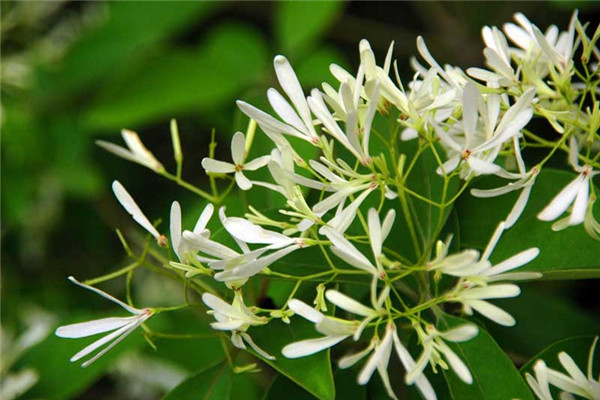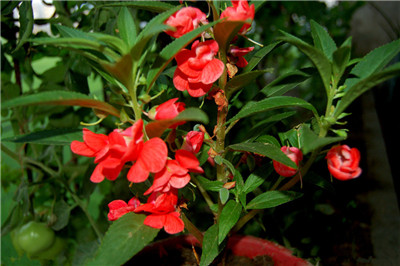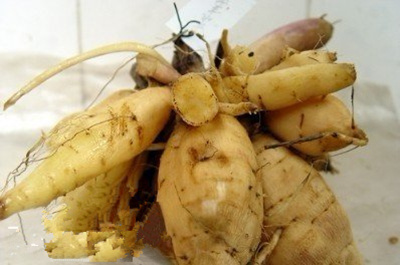The planting method of evening primrose
Night incense is a flower that wins with "night incense" and has won people's love. Like a warm, humid, sunny environment, which can blossom all the year round. The country of origin is Mexico and South America. The planting method of evening primrose should pay attention to the following points.
1. Choose the insert. The branches with strong growth or free of diseases and insect pests should be selected, and the sunny branches in the middle and upper part of the year should be selected on the same plant, requiring short internodes, strong branches and leaves, full bud tips, and unsuitable branches and overgrown branches that are about to blossom.
2. Select the matrix. The bed soil prepared with peat soil and rotten leaf soil is 3 ∶ 3 ∶ 4 respectively. The bed soil prepared in this way has the characteristics of increasing bed temperature, water retention, aeration, fertility and partial acidity, and is suitable for branches to take root and sprout.
3. Deal with cuttings. The cuttings were treated with abt rooting powder before cutting, which had the effect of promoting rooting. Cut the cuttings into 8cm to 12cm segments with 2 to 3 buds above. The cutting □ at the lower part of the cuttings should be 0.5cm below the node, and the □ should be smooth, cutting off the lower leaves, leaving only 2 to 3 leaves at the top, with a depth of about 3cm.
4. The conditions for rooting. The suitable rooting temperature is 20 degrees Celsius to 24 degrees Celsius, and the soil temperature is 3 degrees Celsius to 5 degrees Celsius higher than the temperature. The relative humidity of the bed air is 80% to 90%, which is favorable for rooting and requires light of about 30%. The moisture should be suitable, which is slightly higher at the initial stage of cutting and slightly dry at the later stage. The suitable period for local open-field cutting is from early May to mid-June, which is in a better climate, which can better meet the temperature and humidity conditions needed for cuttings to take root.
5. Strengthen the management after insertion. After planting, it should be watered thoroughly, covered with plastic film, placed in a shaded place, or scattered grass on the film to prevent direct sunlight, and increase light at night to help the cuttings survive. Air is released once or twice a day to replenish the oxygen needed and prevent diseases. To often spray water, keep the inserting bed moderately moist, but do not spray too much water, otherwise the inserting bed is too wet, often affecting the cuttings healing and rooting. When the new root grows to 2 cm to 3 cm, it can be transplanted into the basin at the right time. Nanjing area should be moved into indoor maintenance in winter after flowering.

Selection of Cuttage Propagation cuttings of Corydalis
The cuttings are suitable for selecting the branches with strong growth and no diseases and insect pests, and the sunny branches in the middle and upper part of the same plant, with short internodes, full bud tips and strong branches and leaves are the best.
Selection of matrix
Generally, peat soil and rotten leaf soil can be mixed and prepared according to the proportion of 3 ∶ 3 ∶ 4 respectively, which is beneficial to the rooting and germination of branches.
Deal with the insert
Before cutting, it is best to use ABT rooting powder and other chemicals to treat the cuttings in order to promote their rooting. Cut the cuttings into a section of about 8-12 cm and retain 2-3 buds. The cut in the lower part of the cuttings is generally 0.5 cm below the node. The incision should be smooth, cut off the lower leaves, leaving only 2-3 leaves at the top, and the insertion depth is generally about 3 cm.
Conditions for rooting
The suitable rooting temperature of evening incense is between 20-24 ℃, and the soil temperature is generally higher than air temperature by 3 ℃, which is more favorable for rooting. The relative humidity of the inserting bed air is 80% Mui 90%, and the light is required to be about 30%. The moisture should be suitable, which is slightly higher at the initial stage of cutting and slightly dry at the later stage.
Strengthen the management after insertion
After the cuttage is finished, it should be watered thoroughly, covered with plastic film and placed in a shaded place to avoid direct sunlight. More light is needed at night to help the cuttings survive. Air is released 1-2 times a day to replenish oxygen and prevent diseases. Need to spray water frequently, keep the bed moist moderately, but if you spray too much water, it will affect the cuttings healing and rooting. When the new root grows to 2-3 cm, it can be transplanted into the basin.
The cultivation method of evening primrose, evening primrose, night incense, etc., is a perennial rattan twining herb, distributed in Yunnan, Guangxi, Guangdong and Taiwan, is a kind of semi-wild vegetable with fresh flowers and buds for consumption. It has the effect of clearing the liver and eyesight, and can treat red swelling and pain of the eyes, measles on the eyes, corneal nebula and so on. The main results are as follows: 1. the characteristic characteristic is that the root system of night incense is more developed and there are many lateral roots. Stems trailing, without tendrils. Leaves simple, opposite, long ovoid to broadly ovate, green. Cymes with pale yellowish green flowers. The fruit is pod, lanceolate-cylindrical, apically acuminate. Seeds broadly ovate, apically with white sericeous seed hairs. Nocturnal incense grows mostly in woodland or bushes. Like warm, humid, sunny, well-ventilated, loose and fertile soil, drought-resistant, barren, not waterlogging, not cold-resistant, stop growing after defoliation in winter; branches and long leaves after spring, with axillary buds or flower buds in each node, lateral branches and inflorescences continue to occur with growth, generally blossom one after another from May to October, and smell fragrant when flowering, more fragrant at night. Winter results. 2. Main points of cultivation techniques 1. The method of breeding. Cuttings, striping, ramet or seed can be used to raise seedlings. Cuttage culture is often used. Semi-lignified and robust stem vines are selected during winter and spring. Stem vines with about 30cm and 3 or 5 nodes are cut for cutting, and seedlings are raised in the seedbed or planted directly in the field. Ramet culture is only suitable for plants with more lateral branches near the ground. Nocturnal incense bears little fruit and generally does not need seed breeding. two。 Planting, management and harvesting. Planting in spring and summer, select the plot with good drainage, apply sufficient basic fertilizer to raise the border, 30cm, row spacing 1.0m-1.5m, plant spacing 50~70cm. Open a hole in the border, put the seedlings obliquely in the hole, cover the soil, the seedlings are exposed to the ground, cover the border with a layer of dry weeds and sprinkle with water. Just keep the soil moist in the future. When the seedlings grow to 1m, set up to draw the vine. The way of setting up the frame is similar to planting melons and beans, leaving 2-3 main vines per tree when introducing vines, and the redundant ones are removed. Pick the whole inflorescence when 40% to 50% of the florets are budding and a few flowers are blooming. Generally pick once a day, blooming flowers should be removed, so as not to affect other buds and lose commodity value. Night fragrance generally produces 1200~1800kg per 667m2. 3. Fertilize. After clearing the garden in the first ten days of March every year, shoot-promoting fertilizer was re-applied once, and compound fertilizer 25kg, mature organic fertilizer (soil fertilizer or farm manure) 200~300kg were applied every 667m2 to cultivate soil and cover fertilizer. After every 20-30 days, every 667m2 was drenched with compound fertilizer aqueous solution 15kg or rotten farm manure 500kg, soil cover fertilizer, do not partial application of nitrogen fertilizer. 4. Pest control. At present, it is found that the main pests are mites and shellfish, and the disease is Fusarium wilt. In order to control mites, we can use anti-mite 23 EC 800x solution, 73% mites 2000 times solution and so on. To control shell insects, you can use 40% dimethoate emulsion 600-800 times. To control Fusarium wilt, we can use 600 times of Fusarium wilt 600 times, 50% carbendazim 600 times, and so on. If you find a wilted plant, you should remove it in time, take it outside the garden and burn it, and spread quicklime in the soil around the diseased plant, and replant it one month later.
- Prev

Maintenance of Impatiens
Is it easy to raise impatiens? Reply: Good to raise. After doing a good recovery of impatiens, the following is about to say-how to raise the next impatiens, to the first time to raise impatiens flower friends-a reference. Impatiens is an annual herb with many colors, such as pink, red, purple, white yellow, wine gold, etc., good variation
- Next

Harvesting and storage of Dahlia root tuber
Dahlia is not cold-resistant, mainly because the root tuber can not be frozen, Dahlia root at 0. Dormancy begins at 5 degrees Celsius and frostbite occurs when the temperature is below 0 degrees Celsius, so you cannot overwinter in the open field in North China, and the roots should be harvested before the early frost. Plants and leaves wither and wither after frost. At this time
Related
- Fuxing push coffee new agricultural production and marketing class: lack of small-scale processing plants
- Jujube rice field leisure farm deep ploughing Yilan for five years to create a space for organic food and play
- Nongyu Farm-A trial of organic papaya for brave women with advanced technology
- Four points for attention in the prevention and control of diseases and insect pests of edible fungi
- How to add nutrient solution to Edible Fungi
- Is there any good way to control edible fungus mites?
- Open Inoculation Technology of Edible Fungi
- Is there any clever way to use fertilizer for edible fungus in winter?
- What agents are used to kill the pathogens of edible fungi in the mushroom shed?
- Rapid drying of Edible Fungi

